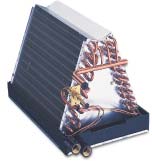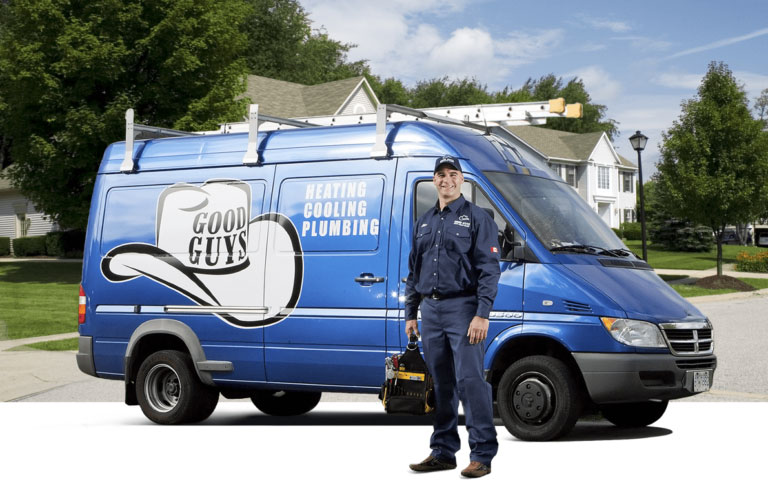Heat Pumps FAQ
How does a heat pump work?
A heat pump is essentially an air conditioner that can also run in reverse. Both rely on the fact that a liquid absorbs heat as it is vaporized into a gas and that a gas releases heat as it condenses into a liquid. When in heating mode, a substance called a refrigerant will be compressed by the main component in a heat pump, the compressor. As it is compressed, it will release heat as it is condensed from a gas to a liquid.
The heated liquid will then be sent through a coil inside your home, where it will gradually cool down as it releases its heat into the ductwork or hot water pipes of your home’s heating system. The liquid will then be sent through an expansion valve, where is will be reduced in pressure as it enters a wider pipe. The liquid will then enter the outdoor coil, where it will absorb heat as it boils into a gas.
When in cooling mode in the summer, the cycle is reversed so that heat is transferred from the indoors to the outdoors.
A typical Energy Star-labelled heat pump can produce heat at efficiencies of around 450% at outdoor temperatures of 20C (78F), which gradually drops down to about 250% at freezing.
What does a heat pump’s HSPF efficiency rating mean, and how can it be compared to the AFUE ratings of gas heating systems?
Estimating the difference in energy costs between an electric and a gas heating system involves two steps. First, the watts of heat energy obtained for each watt of energy consumed must be determined. Second, the cost of each watt of electricity to each watt of natural gas must be compared.
The American Refrigeration Institute tests heat pumps and provides them with efficiency ratings which are recognized by Natural Resources Canada’s Office of Energy Efficiency. The heating efficiency rating is called the heating seasonal performance factor (HSPF) which is defined as the “total heat output in Btu of a heat pump over the entire heating season divided by the total energy in watt hours it uses during that time.” Different HSPF’s are assigned to different regions, as a heat pump’s heating efficiency decreases as the outdoor temperature falls. The HSPF also factors in the use of supplemental heat.
The HSPF of the heat pumps we install ranges between 7.7 and 9.5. Since 3.413 Btu’s are equivalent to 1 watt hour, this equates to efficiencies of between 226% and 278%. As of January 2025, natural gas from FortisBC costs $15.88/GJ (including delivery costs and the carbon tax) and BC Hydro charges 10.97 or 14.08 cents per kWh of electricity (depending how much you use). Since 1 GJ = 277.8 kWh, this means that one GJ of electricity from BC Hydro costs $30.47 or $39.11 per GJ, or 92%-146% more than natural gas. Since heat pumps typically convert 1 watt of heat into 3 watts of electricity, energy savings are expected.
What is the differnce between an air source and a ground source (geothermal) heat pump?
An air source heat pump extracts heat from the outdoor air in heating mode, while a ground source unit extracts heat from the ground. The temperature deep in the ground is constant at about 10C (50F) so a ground source unit can operate more efficiently when air temperatures are below 10C, but will be less efficient at temperatures above 10C. In BC’s mild climate, this means that the energy savings of a ground source unit are marginally greater than with an air source unit. However, ground source units are much more expensive than air source units. They usually cost well over $40,000. An air source unit can provide most of the savings for much less cost (especially after rebates), so they are much more popular and the only ones we install.
Are heat pumps new?
No, they share the same basic technology as refrigerators and air conditioners which were invented over 100 years ago. Heat pumps were first manufactured over 50 years ago and in many regions of the world such as the Southern United States and Italy, heat pumps have been popular and well known for decades. Natural Resources Canada’s 1993 Survey Of Household Energy Use estimated that 2.9% of Canadian households used a heat pump as their primary heat source at that time, while the 2003 survey estimated that over 4% had heat pumps. And it has been in the period between 2003 and the present that the greatest increase in the popularity of heat pumps has occurred.
What is the warranty on a heat pump system? How long can it be expected to last?
Lennox Signature Series heat pumps come with a 10 year warranty on all functional parts, Elite Series come with a 10 year warranty on the compressor and 5 years on other parts, and Merit Series come with a 5 year warranty on all parts.
According to Natural Resources Canada’s Heating and Cooling With a Heat Pump guide, an air source heat pump has an expected life of 15-20 years.
What is Puron?
The previous refrigerant used most commonly in heat pumps and air conditioners, R-22, contained chlorine and was blamed for deteriorating the ozone layer. Puron is Dupont’s trade name for the new chlorine free, non-ozone depleting refrigerant R-410A. All heat pumps we install use R-410A.
How is a heat pump installed? How long does it take?
First, an indoor unit must be connected to your homes furnace or boiler. A bundle of two small copper pipes to carry the refrigerant and a wire for communication will then be run from the indoor unit to the outside of your home where the oudoor unit will be placed. These lines are usually run through a joist spaces in ceilings, through attics or crawl spaces, or along the exterior of the home.


Next, a 220V or greater power line must be run from the breaker panel to the oudoor unit. Additional wires will be run from your furnace to the a new programmable thermostat to control the unit, and the wires run to the outdoor unit will plug into your furnace to control the system.
All of the air in the copper lines connecting the indoor and outdoor units must then be vacuumed out completely (usually overnight) before the correct amount of refrigerant is placed in the system.
This process usually takes two installers about two days. An extra day will probably be required if a new back-up furnace is also being installed (if you have an older furnace and would like a newer, better unit). A heat pump for radiant hot water heating usually takes longer, expecially if several fan units for air conditioning are being installed. These time frames are approximate only, and will vary from installation to instalaltion.
How much energy will a heat pump use cooling the house in the summer?
Some people who have heard residents from places like California complaining about the high cost of air conditioning may be worried that their savings on heating will be negated by air conditioning costs. Fortunately, in BC we have much fewer cooling days and most of them only require a few degrees of cooling, so cooling costs are usually small (at least compaged to heating costs). It is often claimed that cooling costs are usually less than 10% of heating costs in our climate. Of course, you may shut off the air conditioning or only run it on the hottest days if these costs are still a concern.
How much noise does a heat pump make?
We have several models of heat pumps that have noise ratings of under 60dB. This is a little noisier than a normal conversation and a little quieter than most new washing machines are when spinning the clothes.
This amount of noise is not a problem for most people in detached houses, except possibly if the heat pump must be placed right next to a window in a frequently occupied room. Unfortunately, in townhouses, some neighbors and strata councils can be picky about noise, so we might recommend an air conditioner that will only be running on hot summer days and a high-efficiency furnace in these cases.


